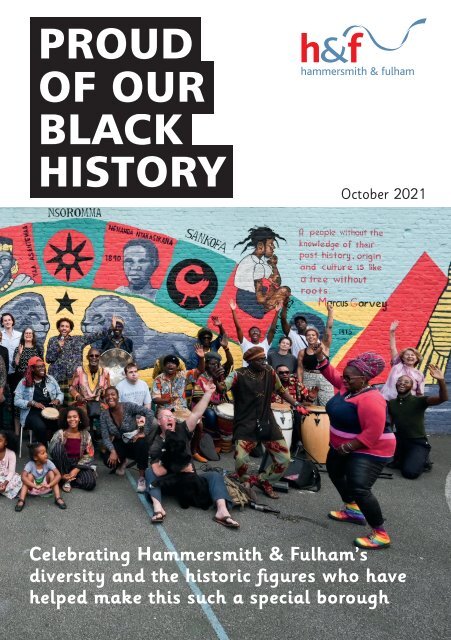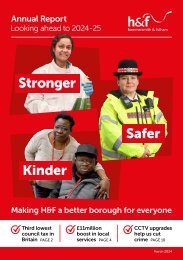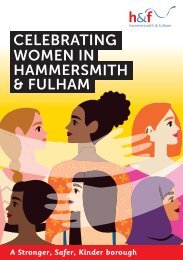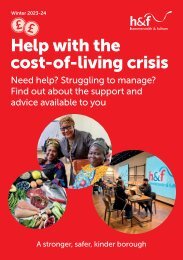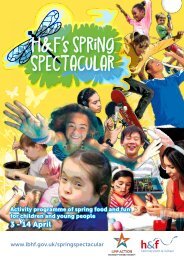Proud of our Black History
Celebrating Hammersmith & Fulham’s diversity and the historic figures who have helped make this such a special borough.
Celebrating Hammersmith & Fulham’s diversity and the historic figures who have helped make this such a special borough.
Create successful ePaper yourself
Turn your PDF publications into a flip-book with our unique Google optimized e-Paper software.
PROUD<br />
OF OUR<br />
BLACK<br />
HISTORY<br />
October 2021<br />
Celebrating Hammersmith & Fulham’s<br />
diversity and the historic figures who have<br />
helped make this such a special borough<br />
1
CONTENTS<br />
<strong>Black</strong> <strong>History</strong> Timeline<br />
BEFORE 1900 4-5<br />
AFTER 1900 6-11<br />
Historic Figures 12-25<br />
Family Tree 18-19<br />
OUR BLACK HISTORY<br />
WE ASKED:<br />
Which historical black individuals lived here?<br />
Were we always a diverse borough?<br />
How did that road get its name?<br />
Did Hammersmith & Fulham play a part in the slave trade?<br />
<strong>Black</strong> <strong>History</strong> Trail 28-31<br />
White City Estate 32-33<br />
Can you help us?<br />
This booklet is not intended to be a complete guide to Hammersmith &<br />
Fulham’s <strong>Black</strong> history. It’s an evolving project and we know just how<br />
big a task it is given H&F’s unique history and diversity. We’re always<br />
searching for historic figures who deserve more recognition or remarkable<br />
locations that have had a big impact in the community. Can you help us?<br />
Do y<strong>our</strong> family members have any stories about moving to H&F or living<br />
in H&F?<br />
Have y<strong>our</strong> parents email us at: press.<strong>of</strong>fice@lbhf.gov.uk<br />
Thank you to the numerous residents and groups who have helped<br />
us get this far, including author Stephen B<strong>our</strong>ne and H&F Archivist<br />
Kath Shawcross.<br />
Picture by Justin Thomas<br />
People love living in Hammersmith<br />
& Fulham. It’s diverse, we care<br />
about <strong>our</strong> neighb<strong>our</strong>s, and we don’t<br />
like unfairness.<br />
To ensure younger residents <strong>of</strong><br />
the borough share in those values,<br />
we launched an investigation into<br />
H&F’s own <strong>Black</strong> history during<br />
BLACK HISTORY MONTH.<br />
We know in the past people<br />
haven’t always shared the same<br />
opinions as we do today. In <strong>our</strong><br />
investigation, we also discovered<br />
that Hammersmith & Fulham has<br />
been home to many brilliant and<br />
distinct ethnic minority people.<br />
The only problem was that, in the<br />
past, people didn’t think they were<br />
important because <strong>of</strong> the col<strong>our</strong> <strong>of</strong><br />
their skin. We call these Hidden<br />
Figures.<br />
Today, we are putting them back<br />
into their proper place in <strong>our</strong><br />
borough’s history.<br />
Over the coming months you’ll<br />
see their names appearing near<br />
the buildings where they lived or<br />
worked as part <strong>of</strong> <strong>our</strong> new H&F<br />
<strong>Black</strong> <strong>History</strong> Trail.<br />
Be sure to keep an eye out!<br />
In the meantime, this booklet will<br />
help you learn their stories and their<br />
place in Hammersmith & Fulham’s<br />
history.<br />
Cllr Sharon<br />
Holder,<br />
H&F Cabinet<br />
Member<br />
Cllr Sue<br />
Fennimore,<br />
Deputy Leader<br />
<strong>of</strong> H&F<br />
Kim Smith,<br />
Chief Executive<br />
<strong>of</strong> H&F Council<br />
2 3
BLACK HISTORY TIMELINE<br />
BEFORE 1900<br />
AD 211<br />
1241<br />
1507<br />
1546<br />
1562<br />
1596<br />
Septimius Severus, the<br />
first Roman Emperor <strong>of</strong><br />
African descent, dies in<br />
York.<br />
Earliest known drawing <strong>of</strong><br />
a black Briton is made in<br />
the Domesday book.<br />
John Blanke is a<br />
trumpeter in the c<strong>our</strong>t <strong>of</strong><br />
Henry VIII. He is the only<br />
black Tudor we know was<br />
pictured.<br />
Jacques Francis is hired<br />
to retrieve the guns from<br />
the sunken Mary Rose.<br />
He later becomes the first<br />
African to give evidence in<br />
an English c<strong>our</strong>t <strong>of</strong> law.<br />
John Hawkins is the first<br />
Englishman to lead a slave<br />
trading voyage. Around 13<br />
million Africans are forcibly<br />
taken from their homes in<br />
subsequent years.<br />
Queen Elizabeth I<br />
authorised a merchant to<br />
transport black people to<br />
Spain and Portugal, with<br />
their masters’ consent.<br />
However, most refused<br />
permission, and more than<br />
360 Africans continued to<br />
live in the British Isles.<br />
1672<br />
1688<br />
1700S<br />
1807<br />
1834<br />
1884<br />
The Royal African<br />
Company is granted a<br />
charter giving it exclusive<br />
rights to carry slaves to the<br />
Americas.<br />
Aphra Behn publishes<br />
her novel Oroonoko about<br />
African royalty. She is one<br />
<strong>of</strong> the first to attack the<br />
slave trade.<br />
By the mid-1700s sugar<br />
is grown entirely by slave<br />
lab<strong>our</strong> and is England’s<br />
biggest import. It is why<br />
some don’t want to abolish<br />
slavery.<br />
The British slave trade<br />
is abolished. However,<br />
it is still legal to own<br />
and buy slaves from<br />
slave traders across the<br />
Empire. Slave owners<br />
were compensated by the<br />
government for “loss <strong>of</strong><br />
goods” for many years to<br />
come.<br />
All slaves (except in<br />
India) are set free.<br />
However, they must work<br />
for their old masters for<br />
free or for low pay until<br />
1840.<br />
European powers<br />
meet to divide Africa<br />
between them. In many<br />
cases the new national<br />
boundaries do not take<br />
into full account the<br />
needs, history or language<br />
<strong>of</strong> the African people.<br />
These decisions<br />
<strong>of</strong>ten led to war and<br />
conflict later on.<br />
4 5
BRITAIN’S BLACK<br />
HISTORY TIMELINE<br />
AFTER 1900<br />
1913<br />
John Archer is elected<br />
Mayor <strong>of</strong> Battersea,<br />
becoming the first black<br />
mayor <strong>of</strong> London.<br />
WW1<br />
<strong>Black</strong> Britons took part<br />
in every part <strong>of</strong> the war<br />
effort. The most famous is<br />
former Tottenham Hotspur<br />
player Lt. Walter Tull.<br />
In Butetown 2,000 white<br />
people attack shops and<br />
homes associated with black<br />
people. Many are hurt.<br />
1919 WW2 1948 1950S<br />
10,000 men and women<br />
from the Caribbean come<br />
to the UK to help with the<br />
war effort.<br />
The Empire Windrush<br />
brings one <strong>of</strong> the largest<br />
groups <strong>of</strong> post-war<br />
immigrants to the UK.<br />
British Caribbean people<br />
who came to the UK<br />
are known as the<br />
Windrush Generation.<br />
After WWII the British<br />
Empire granted India<br />
independence in 1947 and<br />
split the country into two:<br />
India and Pakistan. The<br />
split left between 10 and<br />
20 million people without<br />
a home and created a<br />
large refugee crisis. Many<br />
<strong>of</strong> those refugees fled to<br />
Britain to help fill lab<strong>our</strong><br />
shortages after the war.<br />
1962<br />
The Commonwealth<br />
Immigrants Act restricts<br />
black entry to the UK.<br />
The Act is updated in<br />
1968, 1971 and 1981.<br />
1963<br />
Bristol Bus Boycott:<br />
West Indians and white<br />
supporters refused to use<br />
the Bristol bus service<br />
until the service lifted<br />
their col<strong>our</strong> bar. A col<strong>our</strong><br />
bar is when a company<br />
refuses to employ a person<br />
because they are<br />
not white.<br />
The Race Relations Act<br />
makes racial discrimination<br />
illegal in public places.<br />
Protections are extended<br />
in 1968 and 1976.<br />
1965 1966 1970 1972<br />
The Notting Hill<br />
Carnival is launched by<br />
activist Rhaune Laslett to<br />
celebrate diversity and<br />
help soothe tensions after<br />
the 1958 Notting Hill Race<br />
Riots.<br />
During a peaceful protest<br />
against the unfair police<br />
targeting <strong>of</strong> The Mangrove<br />
Caribbean restaurant in<br />
Notting Hill, the ‘Mangrove<br />
Nine’ were arrested for<br />
causing a riot. The sensational<br />
trial lasted for 55 days before<br />
a judge ruled against the police<br />
and found the activists not<br />
guilty.<br />
6 7<br />
President Idi Amin <strong>of</strong><br />
Uganda ordered 60,000<br />
Asians to leave the country<br />
within 90 days. More<br />
than 30,000 with British<br />
passports fled to the UK.<br />
Here, the government<br />
explored different ways to<br />
stop them from staying,<br />
including giving them money<br />
to surrender their British<br />
passports.
BRITAIN’S BLACK<br />
HISTORY TIMELINE<br />
AFTER 1900<br />
1980S-1990S 1981 1987 1991<br />
1998<br />
The UK has been home<br />
to Somalians since the<br />
19th century when Somali<br />
sailors and ship builders<br />
migrated to find work in the<br />
Royal Navy. However, when<br />
the civil war broke out the<br />
population quickly grew as<br />
women and children fled the<br />
fighting at home. By 1999<br />
53% <strong>of</strong> Somali refugees<br />
applied to come to the UK.<br />
It is thought the UK is now<br />
home to the largest Somali<br />
community in Europe.<br />
The Brixton Riots occur<br />
as tensions rise between<br />
the black British community<br />
and the police over alleged<br />
police brutality. Rioting lasts<br />
for three days and spreads<br />
across the UK.<br />
The UK elects f<strong>our</strong> black MPs<br />
including Diane Abbott, the<br />
first black female MP.<br />
Author Stephen B<strong>our</strong>ne<br />
published a book <strong>of</strong><br />
interviews with Esther Bruce,<br />
his mixed-race adopted aunt<br />
from Fulham. It told her life<br />
story, including her work<br />
as a seamstress as well as<br />
her experiences during the<br />
Second World War when<br />
her father was killed in an<br />
air raid. The book is titled<br />
Esther Bruce – A <strong>Black</strong><br />
London Seamstress: Her<br />
Story 1912-1994. It won<br />
the Raymond Williams Prize<br />
for community publishing<br />
and was described by<br />
the Caribbean Times<br />
as inspirational and<br />
enlightening.<br />
The first black manager<br />
<strong>of</strong> a UK national football<br />
team, Hope Powell was,<br />
Hope was in charge <strong>of</strong><br />
England Women from<br />
1998-2013, twice reaching<br />
the quarter-finals <strong>of</strong> the<br />
Women’s World Cup. Her<br />
20-year playing career<br />
included two years in<br />
Fulham, during which she<br />
appeared in the Women’s<br />
FA Cup final. In 2003 she<br />
became the first woman<br />
to achieve the Uefa Pro<br />
Licence… the highest<br />
coaching qualification.<br />
Widely regarded as one<br />
<strong>of</strong> the finest technical<br />
coaches in the country,<br />
she’s now the Brighton<br />
Women’s manager.<br />
2000<br />
The Race Relations<br />
(Amendment) Act is<br />
passed requiring police,<br />
universities and public<br />
authorities to promote race<br />
equality.<br />
8 9
BRITAIN’S BLACK<br />
HISTORY TIMELINE<br />
AFTER 1900<br />
2001<br />
Former Children’s<br />
Laureate Malorie<br />
<strong>Black</strong>man shot to fame<br />
in 2001 with the first book<br />
in her Noughts & Crosses<br />
series, later a TV series<br />
featuring her superfan<br />
Stormzy. Malorie, 59,<br />
whose parents were both<br />
from Barbados, addresses<br />
racism head-on in her<br />
books. “I wanted to show<br />
black children just getting<br />
on with their lives, having<br />
adventures and solving<br />
their dilemmas, like the<br />
characters in all the books<br />
I read as a child,” she<br />
said. She was made an<br />
OBE in 2008.<br />
2004<br />
A prolific composer and<br />
conductor <strong>of</strong> Jamaican<br />
descent, Shirley<br />
Thompson has written<br />
for film, TV and theatre as<br />
well as creating operas,<br />
concertos, symphonies and<br />
ballets. Shirley Thompson<br />
has combines her own<br />
creativity with teaching<br />
others as Pr<strong>of</strong>essor <strong>of</strong><br />
Music at the University <strong>of</strong><br />
Westminster. Shirley became<br />
the first woman in Europe<br />
to compose and conduct<br />
a symphony in the last<br />
40 years with the 2004<br />
work New Nation Rising,<br />
A 21st Century Symphony,<br />
a celebration <strong>of</strong> 1,000 years<br />
<strong>of</strong> London history.<br />
From humble beginnings<br />
in Somalia, Mo Farah<br />
arrived in West London<br />
aged eight and barely<br />
speaking English. Geared<br />
along by his PE teacher,<br />
he came 9th in the U13s<br />
race at the London Youth<br />
Games in 1994, then went<br />
on to do the long-distance<br />
‘double double’ at the<br />
2012 and 2016 Olympics –<br />
winning gold at 5,000 and<br />
10,000 metres. Knighted<br />
for service to athletics, he<br />
switched to the marathon<br />
and still trains in H&F with<br />
his wife and f<strong>our</strong> children.<br />
2012 2016<br />
Man Utd footballer<br />
Marcus Rashford turns<br />
24 in this <strong>Black</strong> <strong>History</strong><br />
Month, yet is a household<br />
name as a campaigner<br />
against child poverty<br />
and racism. From humble<br />
beginnings (his mother<br />
skipped meals to make sure<br />
the family ate) he joined the<br />
United academy at the age<br />
<strong>of</strong> seven, and scored twice<br />
on his full debut in 2016.<br />
That year he became part<br />
<strong>of</strong> England’s Euro squad.<br />
His campaigning was key<br />
to a government U-turn on<br />
providing free school meals<br />
during summer holidays.<br />
10 11
HISTORIC FIGURES<br />
Did you know a lot <strong>of</strong> famous people who had an impact on <strong>Black</strong> history<br />
worked, lived or are laid to rest in Hammersmith & Fulham?<br />
Sadly they <strong>of</strong>ten get left out <strong>of</strong> history lessons, but it is important - especially<br />
during BLACK HISTORY MONTH - to remember them. Here are just a few<br />
examples <strong>of</strong> the Hidden Figures who have helped influence and shape <strong>our</strong><br />
borough for the better.<br />
Beilby Porteus, 1731-1809<br />
Granville Sharp, 1735-1813,<br />
1<br />
Lived at Fulham Palace between<br />
lived in Fulham, Buried in All<br />
2<br />
1787 and 1809 while Bishop <strong>of</strong> London. Saints Churchyard, SW6<br />
Porteus began battling the slave trade<br />
as Bishop <strong>of</strong> Chester. He pressed<br />
the Church <strong>of</strong> England, owner <strong>of</strong> a<br />
Barbados plantation, to set an example<br />
and teach slaves Christianity. In a 1783<br />
sermon he asked fellow bishops to<br />
back him, and was disappointed when<br />
they refused. In the House <strong>of</strong> Lords<br />
he championed the 1807 Slave Trade<br />
Act which ended the British trade in<br />
enslaved people... a stepping stone to<br />
total abolition.<br />
Sharp was a lawyer and abolitionist<br />
who became famous for protecting<br />
<strong>Black</strong> slaves who had run away from<br />
their masters. He studied laws about<br />
slavery and used what he learnt to<br />
help slaves win their freedom, among<br />
them Jonathan Strong and James<br />
Somerset.<br />
Mary Seacole, 1805-1881,<br />
3 Ellen & William Craft,<br />
Buried in St Mary’s Catholic<br />
1820s-1900,<br />
4<br />
Cemetery, 679-681 Harrow Road,<br />
NW10 5NU<br />
Lived at 26 Cambridge Grove,<br />
W6 0LA<br />
Seacole was a nurse during the Crimean<br />
War. She came to London at the age<br />
<strong>of</strong> 50 and asked if she could tend to<br />
the sick and wounded in the Crimea.<br />
She was rejected. Determined to help,<br />
she paid her own travel costs and set<br />
<strong>of</strong>f to help. There, she built her own<br />
hospital and even went to help soldiers<br />
on the battlefield during the fighting!<br />
The men wrote to the newspapers about<br />
her heroic efforts. When Mary returned<br />
from the war, she was very poor but the<br />
soldiers she helped hadn’t forgotten her.<br />
They threw a big festival and raised a lot<br />
<strong>of</strong> money to help her.<br />
The Crafts were ex-slaves who escaped<br />
from the American South to the North,<br />
with Ellen dressed as a man to avoid<br />
detection. They made their way to<br />
the UK, settling in Hammersmith after<br />
the Fugitive Slave Act was passed<br />
in America. Ellen was a part <strong>of</strong> the<br />
Women’s Rights movement.<br />
12 13
Fanny Eaton, 1835-1924,<br />
Lived at 19 St Dunstan’s Road,<br />
SW6 6AR<br />
Buried in Margravine Cemetery<br />
Eaton was born in Jamaica then<br />
moved to London in the 1840s.<br />
She became a famous model for the<br />
Pre-Raphaelites - a group <strong>of</strong> English<br />
painters, poets and art critics.<br />
She appears in many famous pieces <strong>of</strong><br />
art including William Richmond’s<br />
The Slave, which can be found in Tate<br />
Britain.<br />
5<br />
Edmonia Lewis, 1844-1907,<br />
6<br />
Lolita Roy, 1865,<br />
7<br />
Mahatma Gandhi, 1869-1948,<br />
Lived at 154 Blythe Road,<br />
Lived at 77 Brook Green,<br />
lived at 20 Barons C<strong>our</strong>t Road<br />
8<br />
W14 0HD<br />
W6 7BE<br />
- there is an English Heritage<br />
blue plaque to him there.<br />
Lewis was the fi rst African-American<br />
sculptor to gain national and then<br />
international fame. On her mother’s<br />
side she was descended from Native<br />
Americans and her native name was<br />
“Wildfi re”. In her work she focused<br />
on both <strong>Black</strong> and Native American<br />
people and their history.<br />
Roy was an Indian social reformer<br />
and suffragist who fought for women’s<br />
rights in Britain and India. During<br />
WWI she set up a fund for Indian<br />
soldiers and raised a lot <strong>of</strong> money<br />
through auctions and clothing sales.<br />
After the war she continued speaking<br />
out for women’s rights across the<br />
British Empire.<br />
Gandhi is most famous for his peaceful<br />
protests against British rule in India.<br />
For three years, while he studied law<br />
at University College London, he lived<br />
in Fulham. During his time in London<br />
he worked with London’s poorest to try<br />
to improve their health and treatment.<br />
14 15
Sri Aurobindo, 1872-1950,<br />
Lived at 49 St Stephens<br />
Avenue, W12 8JB<br />
Aurobindo was an Indian spiritualist<br />
and poet who wanted Indian<br />
independence. As a teenager he went<br />
to St Paul’s School in Hammersmith<br />
where he became inspired by rebels<br />
such as Joan <strong>of</strong> Arc and Giuseppe<br />
Mazzini and learnt how India was<br />
ruled by Britain. This is what later<br />
made him join the fi ght for Indian<br />
independence.<br />
9 Marcus Garvey, 1887-1940, 10 Amy Jacques Garvey,<br />
11 Jomo Kenyatta, 1897-1978,<br />
Lived at 53 Talgarth Road,<br />
1895-1973,<br />
Lived at 57 Castletown Road,<br />
12<br />
W14 9DD<br />
Lived at 53 Talgarth Road,<br />
W14 9HG<br />
W14 9DD<br />
Garvey was a Pan-Africanist who<br />
founded the Universal Negro<br />
Improvement Association (UNIA).<br />
The organisation was designed to<br />
strength bonds between <strong>Black</strong> people<br />
all around the world, including Africa,<br />
and advance their rights. The UNIA<br />
was one <strong>of</strong> the largest anticolonialism<br />
groups in Jamaica and had a big<br />
impact on the country.<br />
AJ was a famous j<strong>our</strong>nalist and<br />
speaker for the Pan-African movement.<br />
In the UNIA she was as important<br />
as her husband Marcus, and ran the<br />
organisation alone when he was in<br />
prison. She edited The Negro World, a<br />
paper which was used by the Harlem<br />
Resistance to promote art, culture and<br />
political articles.<br />
Kenyatta was Prime Minister <strong>of</strong> Kenya<br />
and was later its fi rst President. He<br />
was the fi rst indigenous (born in<br />
Kenya) leader, and helped Kenya<br />
transform from a British colony to<br />
an independent country. He lived in<br />
London for three years, making<br />
friends with communists and other<br />
anti-imperialists (people who didn’t<br />
want to be ruled by Britain).<br />
16 17
FAMILY<br />
TREE<br />
Me<br />
ACTIVITY<br />
Can you draw y<strong>our</strong> family tree?<br />
Put y<strong>our</strong> parents below and keep going<br />
back to oldest relatives<br />
Ask y<strong>our</strong> parents for help and see how<br />
many people you can include.<br />
18<br />
19
.<br />
Indra Lal Roy, 1898-1918,<br />
Lived at 77 Brook Green,<br />
W6 7BE<br />
Son <strong>of</strong> the famous Lolita Roy, Indra<br />
Lal Roy achieved his own fame by<br />
becoming the fi rst and only Indian<br />
fl ying ace in WWI. When war broke<br />
out, Roy was still at school. He applied<br />
to the RAF, but was turned down due<br />
to poor eyesight. Keen to help the war<br />
effort, he saw an eye specialist and<br />
had the decision overturned. In 170<br />
h<strong>our</strong>s <strong>of</strong> flying, Roy won 10 battles.<br />
Sadly he was killed in 1918 in France.<br />
13 Adelaide Louise Estelle Hall<br />
1901-1993<br />
Lived at Fairholme Road, W14<br />
Born in New York, Adelaide became<br />
one <strong>of</strong> the best-loved jazz and<br />
cabaret singers and tap dancers, and<br />
performed with legends such as Duke<br />
Ellington, Fats Waller, Josephine<br />
Baker and Louis Armstrong. In<br />
1941, she was Britain’s highest paid<br />
entertainer. She was one <strong>of</strong> the fi rst<br />
<strong>Black</strong> performers to top the bill at the<br />
London Palladium, and played to full<br />
houses at the Hammersmith’s Riverside<br />
Studios and the Hammersmith Palais.<br />
She frequently appeared on the BBC<br />
as well as recording extensively for<br />
Decca Records. In the early 1950s,<br />
Hall and her husband Bert opened the<br />
Calypso Club in Regent Street. She<br />
lived in Fulham from 1980 until her<br />
death at 92 in Charing Cross Hospital.<br />
14 Esther Bruce, 1912-1994,<br />
Lived at Dieppe Street, W14<br />
From a young age, Bruce was taught<br />
by her father to take pride in her<br />
<strong>Black</strong> heritage and stand up to racism.<br />
During WWII she volunteered as a<br />
Fire Watcher – people who stood on<br />
ro<strong>of</strong>tops during air raids and helped<br />
put out fi res caused by bombs.<br />
She also united her community by<br />
writing to her family in Guyana for<br />
food parcels and sharing what she<br />
was sent with her neighb<strong>our</strong>s.<br />
15 Reginald Charles Foresythe<br />
1907-1958<br />
16<br />
Lived in 15 Hetley Road, W12<br />
The jazz pianist, composer and<br />
bandleader was born in Hetley<br />
Road, W12, growing up in the<br />
area’s west African community. In<br />
the early 1930s, he was established<br />
in the American jazz scene, writing<br />
arrangements for Earl Hines and<br />
recording with Benny Goodman and<br />
Gene Krupa. Louis Armstrong and Fats<br />
Waller recorded his tunes, and he later<br />
became the accompanist to American<br />
singer Elisabeth Welch when she visited<br />
the UK. In the Second World War, he<br />
served as an intelligence <strong>of</strong>fi cer. He<br />
died, aged just 51, after a fall at his<br />
home in Paddington.<br />
20 21
HORRIBLE HISTORY<br />
Unfortunately, not everybody who lived in Hammersmith & Fulham<br />
thought that <strong>Black</strong> people and other ethnic minorities should have the<br />
same rights as white people. When they were alive these opinions were<br />
not uncommon, but today we know they are wrong. Below are examples<br />
<strong>of</strong> famous local Historic Figures who played a negative role in the UK’s<br />
<strong>Black</strong> history<br />
Fela Kuti, 1938-1997<br />
Lived at 12 Stanlake Road,<br />
W12 7HP<br />
Fela Kuti was a Nigerian singer, multiinstrumentalist,<br />
bandleader, political<br />
activist and regarded as the founder <strong>of</strong><br />
the infl uential musical style ‘Afrobeat’.<br />
He moved to London in 1958 and<br />
studied at Trinity College <strong>of</strong> Music (his<br />
parents wanted him to be a doctor!).<br />
He married his fi rst wife, Remilekun<br />
(Remi) Taylor in 1960, and had three<br />
children (Femi, Yeni, and Sola). In<br />
1963, he moved back to the newly<br />
independent Federation <strong>of</strong> Nigeria<br />
and attempted to run for its fi rst<br />
presidency. In 1984, he was jailed for<br />
20 months in Nigeria for his political<br />
views.<br />
17 Dr John Alcindor 1873-1924 18<br />
Buried in St Mary’s Catholic<br />
Cemetery, 679-681 Harrow Road,<br />
NW10 5NU<br />
Originally from Trinidad, Alcindor was<br />
a talented and popular doctor who<br />
worked in London. When WWI broke<br />
out, he was eager to help and in 1914<br />
he applied to join the Royal Army<br />
Medical Corp. Sadly he was rejected<br />
because <strong>of</strong> his “colonial origin”. Instead<br />
<strong>of</strong> being sad, Alcindor was determined<br />
to help and signed up as a Red Cross<br />
volunteer where he helped soldiers<br />
returning from the front line. He was<br />
awarded a Red Cross Medal for his life<br />
saving work. After the war he became<br />
a senior district medical <strong>of</strong>fi cer for<br />
Paddington and became known for his<br />
excellent patient care no matter their<br />
origin or race. He became known as<br />
the “<strong>Black</strong> doctor <strong>of</strong> Paddington.”<br />
Sir Nicholas Crisp,<br />
1599-1666<br />
Crisp was a wealthy merchant and<br />
royalist who supported Charles I<br />
during the English Civil War. He is<br />
famous for his brickworks. Crisp was<br />
also involved in the Slave Trade.<br />
Using glass beads he made on site<br />
at his house, Crisp bought and sold<br />
slaves across the Atlantic.<br />
Frederick Marryat,<br />
1792-1848<br />
Today, Marryat is famous for<br />
his children’s stories about naval<br />
adventures during the height <strong>of</strong> the<br />
British Empire. His father, Joseph<br />
Marryat, was a known slave-owner<br />
and fought against the end <strong>of</strong> the<br />
Slave Trade. Like his father, Frederick<br />
defended the Slave Trade and believed<br />
that Africans were not ready to be<br />
free. His stories also contained wrong<br />
and hurtful descriptions <strong>of</strong> <strong>Black</strong><br />
people.<br />
22 23
Fulham Road<br />
New Kings Road<br />
Wandsworth Bridge Rd<br />
Wan<br />
A3220<br />
6<br />
7<br />
13<br />
Brook Green<br />
1<br />
Bishop Beilby Porteus<br />
10<br />
2<br />
Granville Sharp<br />
11<br />
3<br />
Mary Seacole<br />
12<br />
4<br />
Ellen & William Craft<br />
13<br />
5<br />
Fanny Eaton<br />
14<br />
6<br />
Edmonia Lewis<br />
15<br />
7<br />
Lolita Roy<br />
16<br />
8<br />
Mahatma Gandhi<br />
17<br />
9<br />
Sri Aurobindo<br />
18<br />
Shepherds Bush Rd<br />
North End Rd<br />
Hammersmith Rd<br />
10 11<br />
Talgarth Rd<br />
5<br />
12<br />
15<br />
8<br />
14<br />
Lillie Road<br />
Fulham Palace Road<br />
North End Rd<br />
Dawes Road<br />
Fulham Road<br />
1<br />
2<br />
Marcus Garvey<br />
Amy Jacques Garvey<br />
Jomo Kenyatta<br />
Inra Lal Roy<br />
Esther Bruce<br />
Adelaide Louise Estelle Hall<br />
Reginald Charles Foresythe<br />
Fela Kuti<br />
Dr John Alcindor<br />
Putney Bridge<br />
Harrow Road<br />
3<br />
18<br />
Scrubs Lane<br />
West Way<br />
Wood Lane<br />
Bloemfontein Rd<br />
Uxbridge Road<br />
17<br />
9 16<br />
Goldhawk Road<br />
4<br />
King Street<br />
Great West Road<br />
Hammersmith Bridge<br />
Historic Figures<br />
Where they were born,<br />
lived, died or were buried<br />
in Hammersmith & Fulham<br />
Du Cane Road<br />
d Oak Common Lane<br />
Ol<br />
24
SANKOFA<br />
ACTIVITY<br />
The word Sank<strong>of</strong>a comes from the Akan people<br />
<strong>of</strong> Ghana. One <strong>of</strong> the Adinkra symbols for<br />
Sank<strong>of</strong>a depicts a mythical bird.<br />
Col<strong>our</strong> in the mythical bird symbol.<br />
26<br />
27
HISTORIC LANDMARKS<br />
IN LOCAL BLACK HISTORY<br />
Want to see the historic landmarks <strong>of</strong> H&F’s <strong>Black</strong> history for y<strong>our</strong>self?<br />
Use the map on page 30 and 31 to visit the spots on the trail.<br />
5<br />
Goldhawk Road fabric district<br />
near Shepherds Bush Market, W12<br />
Home <strong>of</strong> the famous fabric quarter, the shops here are over<br />
150 years old and businesses have been passed down<br />
through the generations. From Swedish rag rugs and Scottish<br />
tartans, to bold African prints and Indian silk shawls,<br />
shoppers can fi nd imported fabrics from across the globe.<br />
1<br />
Hammersmith Palais<br />
242 Shepherds Bush Road, W6<br />
The Palais was a dance hall and entertainment venue<br />
that was open from 1919 to 2007. It was the fi rst <strong>of</strong> its<br />
kind to be built in Britain and quickly became known to<br />
many as the mainstay <strong>of</strong> dances and later the punk and<br />
reggae scene in London.<br />
6<br />
Peckings Records<br />
81 Askew Road, W12<br />
Reggae music pioneer George ‘Peckings’ Price was one <strong>of</strong><br />
the fi rst to import the sound <strong>of</strong> the Caribbean to London.<br />
He set up a recording studio in Kingston, Jamaica, before<br />
moving to Shepherds Bush where he opened a shop in<br />
142 Askew Road in 1972. Peckings Records is still a thriving<br />
business in its new location at 81 Askew Road, and is run by<br />
his two sons, Chris and Duke.<br />
2<br />
Hammersmith Odeon (now the Eventim Apollo)<br />
Hammersmith Broadway, W6<br />
Built in 1932 as a cinema, the Odeon took on a exalted<br />
place in London’s music folklore. Bob Marley played a series<br />
<strong>of</strong> gigs in 1976. It is now re-branded as the Apollo and is<br />
still one <strong>of</strong> London’s major live entertainment venues.<br />
7<br />
Island Records<br />
22 St Peter’s Square, W6<br />
Chris <strong>Black</strong>well, the founder <strong>of</strong> esteemed record label Island<br />
Records, brought the sound <strong>of</strong> Jamaica to Britain. In 1973,<br />
the growing label opened a small basement studio here in<br />
West London where artists such as Bob Marley and the<br />
Wailers and Steel Pulse recorded some <strong>of</strong> their most<br />
famous work.<br />
3<br />
4<br />
Greensleeves Records<br />
44 Uxbridge Road, W12<br />
Opened in 1977, this reggae shop was home to the number<br />
one label for the sound <strong>of</strong> the Caribbean, and for Caribbean<br />
infl uenced <strong>Black</strong> British music. Musicians such as Shaggy and<br />
Sean Paul had pop crossovers with this record label.<br />
Shepherds Bush Market<br />
Between Goldhawk Road and Uxbridge Road, W12<br />
Opened in 1914, the market is home to a diverse range <strong>of</strong><br />
traders selling everything from food and fabric to household<br />
goods and electronics. In more than a century it closed only<br />
once, in 1915, due to the First World War. It reopened in<br />
1918 when ex-soldiers from across the Empire were <strong>of</strong>fered<br />
stalls to help restart their lives.<br />
ACTIVITY<br />
Visit these sites y<strong>our</strong>self! Swing by on y<strong>our</strong> way<br />
home from school or take y<strong>our</strong> whole family<br />
out for a walk at the weekend using <strong>our</strong> handy<br />
map on the next page.<br />
28 29
No<br />
Hammersmith Rd<br />
Brook Green<br />
Talgart<br />
A3220<br />
Fulham Palace Road<br />
ood Lane<br />
2<br />
3<br />
Shepherds Bush Rd<br />
5<br />
1<br />
Goldhawk Road<br />
emfontein Rd<br />
Uxbridge Road<br />
King Street<br />
Great West Road<br />
Hammersmith Bridge<br />
1<br />
1<br />
6<br />
4<br />
Askew Road<br />
7<br />
30<br />
31
WHITE CITY ESTATE<br />
The construction <strong>of</strong> the White City Estate began in the late 1930s and<br />
was finished after the Second World War. It is named after the White City<br />
Exhibition that took place on the site in 1908.<br />
The estate was built by the London County Council. Twenty-three blocks<br />
were completed by the outbreak <strong>of</strong> the war, with the rest completed<br />
afterwards.<br />
Most <strong>of</strong> the names <strong>of</strong> the buildings on the White City Estate are named<br />
after men who served the British Empire in various colonial settings –<br />
mainly in India.<br />
The White City Exhibition <strong>of</strong> 1908 was a<br />
huge 200-acre site with palaces, halls, stadium<br />
and canals. It looked very similar to Venice!<br />
The buildings were covered white stucco<br />
(decorative plaster), but the name didn’t just<br />
come from the exhibition’s white buildings.<br />
Entertainer Imre Kiralfy was the mastermind behind the project and<br />
‘borrowed’ the White City name from Chicago.<br />
‘Aerial view <strong>of</strong> the White<br />
City Estate, Hammersmith’<br />
from The County <strong>of</strong> London<br />
Plan (1943) – showing<br />
the Estate as completed<br />
by 1939.<br />
The first exhibition was open from May to October 1908. It attracted more<br />
than eight million visitors and celebrated Britain’s friendship with France<br />
after the signing <strong>of</strong> the Entente Cordiale in 1904.<br />
Today, many <strong>of</strong> the roads in the area are named after African locations<br />
and countries that had displays at the White City Exhibition including<br />
South Africa Road, India Way, Bloemfontein Road, L<strong>of</strong>tus Road,<br />
Australia Road and New Zealand Way.<br />
32 33
LOCAL STUDIES<br />
& ARCHIVES<br />
Thank you to the numerous residents and groups who have helped us<br />
get this far, including author Stephen B<strong>our</strong>ne and H&F Archivist Kath<br />
Shawcross.<br />
Get in touch with the Local Studies & Archives<br />
Are you interested in tracing y<strong>our</strong> family history, house history or<br />
researching the changes in y<strong>our</strong> local area over the years? Whatever y<strong>our</strong><br />
interests, the staff and volunteers will be happy to assist y<strong>our</strong> research,<br />
either in person at Hammersmith Library (pictured below) or via post or<br />
email.<br />
The Hammersmith & Fulham Local Studies and Archives Centre holds the<br />
archives and local history collections for the borough, including documents,<br />
books, maps, photographs, old newspapers and other s<strong>our</strong>ces for family<br />
and local history. These records come from the council and its predecessor<br />
bodies, local institutions such as churches and schools, local businesses,<br />
local organisations and individuals.<br />
For more details, please visit: www.lbhf.gov.uk/archives<br />
34 35
WHO ARE YOU<br />
Y<strong>our</strong> name<br />
Class name<br />
36


